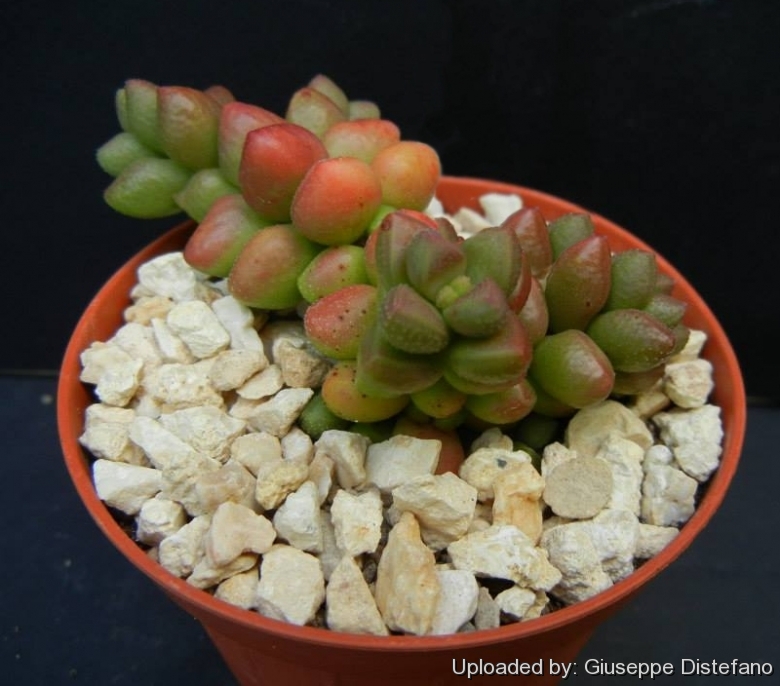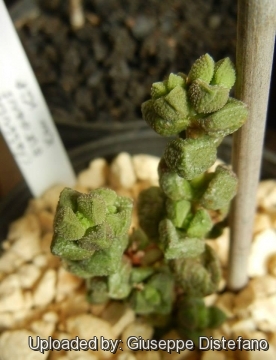
Crassula elegans Photo by: Giuseppe Distefano
Origin and Habitat: Cape Province, South Africa (Bushmanland) to Namibia
Habitat: This species is widespread and often locally common and prefers to grow on sandy soil and in partial shade.
Synonyms:
See all synonyms of Crassula elegans
Common Names include:
ENGLISH: Elegant Crassula
Description: Crassula elegansSN|25627]]SN|25627]] (a.k.a. Elegant Crassula) is a lovely dwarf species that comes from a wide area, and a multitude of somewhat different looking forms are available under this name.
Habit: It is a sprawling, perennial, leaf-succulent, up to 80 mm high but usually with short stems and much branched, with old leaves completely shrivelled.
Roots: Shallow and short. The root/shoot ratio is low during time of drought, but upon wetting of the soil the plant rapidly forms adventitious, deciduous rootlets which temporarily increase the root/shoot ratio.
Leaves: Ovate to somewhat lanceolate, 5-15 long and 4-8 (-10) mm broad, obtuse rarely acute, broadly triangular in section, intense green, often with brownish red to ruby red tips in full sun. Threaded along a wiry stem closely packed so that internodes are rarely visible between them and rarely obviously 4-ranked, glabrous, with fine hairs or with coarse rounded papillae.
Inflorescence: It produces loose rounded thyrse at the plant apex with short peduncle (15-)25-60 mm long, covered with recurved hairs.
Flowers: Inconspicuous, very small white, cream, beige or yellowish often fading to brown, slightly perfumed. Calyx lobes triangular, 1-1,5 mm long, obtuse, covered with fine hairs and marginal cilia, fleshy, green to red. Corolla tubular, fused basally for 0,3-0,5 mm; lobes oblong-elliptic, 2-2,5 mm long, obtuse, spreading to recurved. Stamens with brown anthers.
Blooming season: Late-summer to autumn or winter.
Subspecies, varieties, forms and cultivars of plants belonging to the Crassula elegans group
 Crassula elegans Schönland & Baker f.: Leaves ovate to somewhat lanceolate, broadly triangular in section with fine hairs or with coarse rounded papillae. Distribution: Cape Province, South Africa (Bushmanland) to Namibia
Crassula elegans Schönland & Baker f.: Leaves ovate to somewhat lanceolate, broadly triangular in section with fine hairs or with coarse rounded papillae. Distribution: Cape Province, South Africa (Bushmanland) to Namibia Crassula elegans subs. namibensis (Friedrich) Toelken: Leaves small mostly ovate with obtuse apices, glabrous and covered with papillae. Distribution: Southern Namibia.
Crassula elegans subs. namibensis (Friedrich) Toelken: Leaves small mostly ovate with obtuse apices, glabrous and covered with papillae. Distribution: Southern Namibia.
Bibliography: Major references and further lectures
1) Hermann Jacobsen “Abromeitiella to Euphorbia” Blandford Press, 1960
2) Michael Evenari, Imanuel Noy-Meir, David W. Goodall "Hot Deserts and Arid Shrublands", Volume 12, Part 2 Elsevier, 1986
3) Dr J.P. Roux "Flora of South Africa" 2003
4) Sonja Loots “Red Data Book of Namibian Plants” Southern African Botanical Diversity Network Report No. 38 2005
 Crassula elegans habitat of Vanrhynsdorp SW Namibia. Photo by: © Plantemania
Crassula elegans habitat of Vanrhynsdorp SW Namibia. Photo by: © Plantemania Crassula elegans Kon Kip, South Africa. Photo by: Giuseppe Distefano
Crassula elegans Kon Kip, South Africa. Photo by: Giuseppe Distefano Crassula elegans Kon Kip, South Africa. Photo by: Giuseppe Distefano
Crassula elegans Kon Kip, South Africa. Photo by: Giuseppe DistefanoSend a photo of this plant.The gallery now contains thousands of pictures, however it is possible to do even more. We are, of course, seeking photos of species not yet shown in the gallery but not only that, we are also looking for better pictures than those already present.
Read More... Cultivation and Propagation: Crassula elegansSN|25627]]SN|25627]] are of easy cultivation and relatively low maintenance, which makes them a good houseplant, and can be an excellent subject for the beginning succulentophile (they can grow easily on window sills, verandas and in miniature succulent gardens where they are happy to share their habitat with other smaller succulent plants, or in outdoor rockeries). They are spring and autumn grower (summer dormant).
Soil: They are tolerant of a wide range of soils and habitats, but prefer a very porous potting mix to increase drainage. A non-acid soil is ideal. You can grow a plant in a 6-10 cm pot for years and have perfectly happy plants. For best results, use a shallow pot.
Watering: Provide some water all year around, in the wild most of the growth occurs during spring and autumn. During the hot summer months, the soil should be kept moist but not overly wet. During the winter months, water only when the soil becomes completely dry. Wet soil quickly causes root and stem rot, especially during chilly winter months, but can re-root if taken care of. No water should ever be allowed to stand around the roots. Low ambient humidity is always needed.
Fertilization: The plants are fertilized only once during the growing season with a balanced fertilizer diluted to ½ the recommended strength.
Sun Exposure: They need full sun or bright, filtered light with ample airflow to stay compact, but avoid direct blasting sun in mid summer (with sun exposure the leaf develops a nice reddish tint). Bright light is required to prevent "stretching" of crassulas ("stretching" occurs when a moderately fast growing plant such as a Crassula, is grown in dim light or over-fertilized, which causes overly lush growth that contributes to weak, pallid plants that fall over and rot easily).
Pest & diseases: Crassulas are sensitive to mealybugs.
Rot: Rot is only a minor problem with Crassula if the plants are watered and “aired” correctly. If they are not, fungicides won't help all that much. Care must be given in watering, keeping them warm and wet while growing, and cooler and dry when dormant.
Hardiness: Although the plants will survive mild frost if kept dry (hardy as low as -5° C) they should be protected from frost to prevent scarring. USDA 9b-12
Use: It is an excellent potted plant great for windowsill culture as well as in rock gardens. Indoors only in brightest position.
Pruning: Remove old leaves from plant base and dead flower spikes only.
Propagation: They are easily propagated by the removal of off shoots, remove a lateral shoot and insert the basal part buried in the soil. This shoot should root within a month, and small offshoots will form at the base. They can also be grown from seed.













